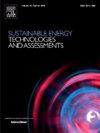Advancing renewable energy technologies in remote areas: Exploring key success factors and interdependencies for sustainable wind energy development
IF 7
2区 工程技术
Q1 ENERGY & FUELS
Sustainable Energy Technologies and Assessments
Pub Date : 2025-05-29
DOI:10.1016/j.seta.2025.104367
引用次数: 0
Abstract
As the global transition toward renewable energy intensifies, remote and underserved regions face a dual challenge: growing energy demand and limited access to centralized power infrastructure. Wind energy, with its scalability and low environmental impact, offers a promising solution—particularly in regions such as China’s Dabie Mountains. This study proposes a comprehensive evaluation framework and employs an interval neutrosophic DANP (Decision-Making Trial and Evaluation Laboratory-based Analytic Network Process) model to identify and prioritize key success factors for sustainable wind energy development (SWED) in remote areas. Based on expert input from ten professionals experienced in wind energy deployment in the Dabie Mountain region, the study examines the interdependencies among 18 evaluation criteria, which are categorized under five key dimensions: technological, economic, social, environmental, and market demand. Results reveal that “supply–demand balance,” “wind energy consumption potential,” and “local utilization capacity” are the three top influential factors in determining long-term success. The study not only introduces a novel model but also provides practical insights for aligning renewable energy planning with local needs, resource conditions, and sustainability goals. Its findings offer targeted policy recommendations for accelerating equitable and resilient energy transitions in remote and resource-rich communities.
在偏远地区推进可再生能源技术:探索可持续风能发展的关键成功因素和相互依赖关系
随着全球向可再生能源过渡的加剧,偏远和服务不足的地区面临着双重挑战:不断增长的能源需求和有限的集中式电力基础设施。风能具有可扩展性和低环境影响,提供了一个很有前途的解决方案,特别是在中国的大别山等地区。本研究提出了一个综合评价框架,并采用区间中性的DANP (Decision-Making Trial and evaluation Laboratory-based Analytic Network Process)模型来识别和优先考虑偏远地区可持续风能开发(SWED)的关键成功因素。基于10位在大别山地区风电部署方面经验丰富的专业人士的专家意见,该研究考察了18项评估标准之间的相互依赖关系,这些标准分为五个关键维度:技术、经济、社会、环境和市场需求。结果表明,“供需平衡”、“风能消费潜力”和“当地利用能力”是决定长期成功的三个主要影响因素。该研究不仅提出了一个新颖的模型,而且为将可再生能源规划与当地需求、资源条件和可持续发展目标相结合提供了实用的见解。其研究结果为加快偏远和资源丰富社区公平和有弹性的能源转型提供了有针对性的政策建议。
本文章由计算机程序翻译,如有差异,请以英文原文为准。
求助全文
约1分钟内获得全文
求助全文
来源期刊

Sustainable Energy Technologies and Assessments
Energy-Renewable Energy, Sustainability and the Environment
CiteScore
12.70
自引率
12.50%
发文量
1091
期刊介绍:
Encouraging a transition to a sustainable energy future is imperative for our world. Technologies that enable this shift in various sectors like transportation, heating, and power systems are of utmost importance. Sustainable Energy Technologies and Assessments welcomes papers focusing on a range of aspects and levels of technological advancements in energy generation and utilization. The aim is to reduce the negative environmental impact associated with energy production and consumption, spanning from laboratory experiments to real-world applications in the commercial sector.
 求助内容:
求助内容: 应助结果提醒方式:
应助结果提醒方式:


